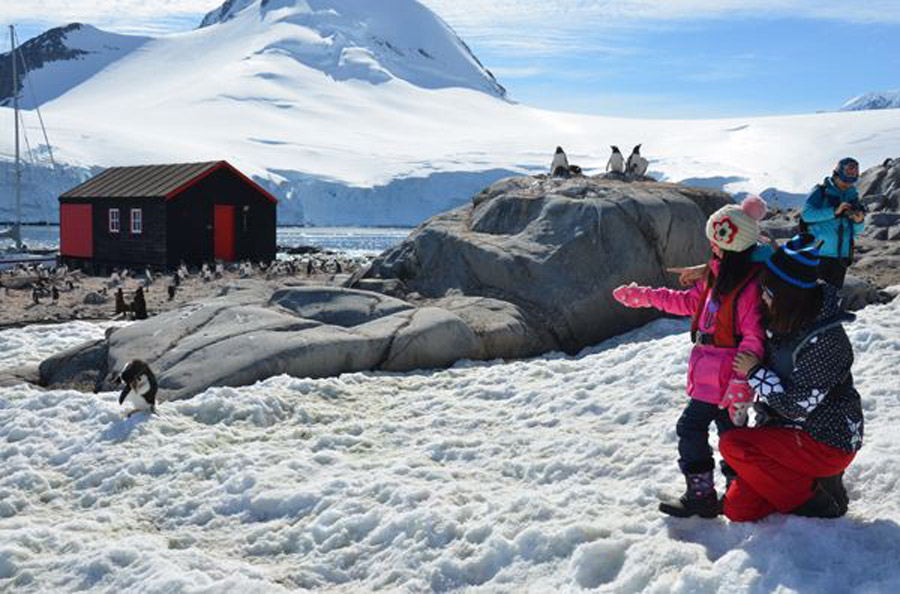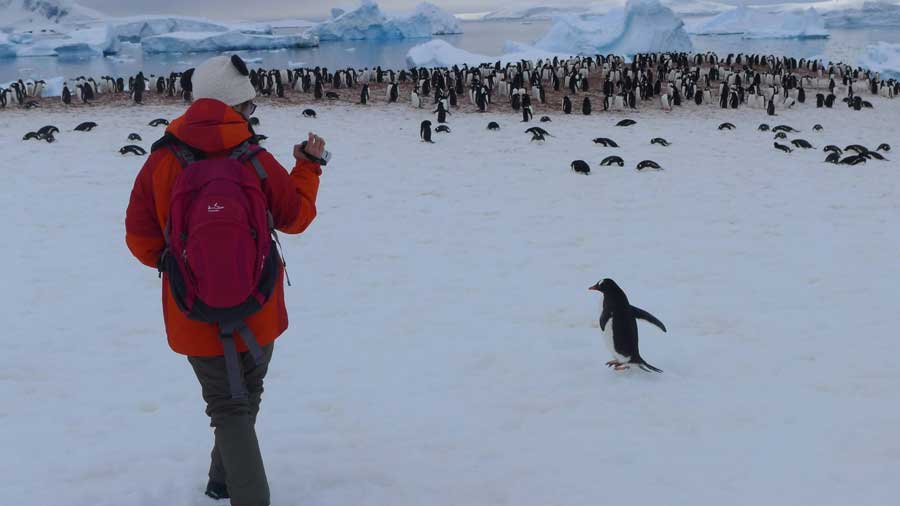

Chinese tourists’ growing passion to travel to the Polar Regions draw environmentalists concerns
It is hard to name a place where there is no Chinese. They travel, study, work, and live in almost all countries and regions across the globe; and some even set their eyes to the universe.
As the so-called last “frontier” on the Earth, the Polar Regions – Antarctica and Arctic – naturally welcome many Chinese tourists as well. And the number has been rising, which has made experts concerned over the possible impact of the increasing population on the fragile regions – some of whom are ill-prepared for Polar expeditions.

(File photo of a woman and a young girl looking at a penguin in Antarctica)
Ever growing market
Speaking at the China Adventure Tourism Forum on Sept. 20, China Tourism Association (CTA) Secretary General Zhang Rungang said that China has become the world’s second largest country of passenger sources to Antarctica. In 2016, the number of Chinese tourists who traveled to Antarctica was 3,944, some 15 percent of the total.
Tens of thousands of tourists head to the Arctic region every year and about 1/4 or even half of those landing on the North Pole are Chinese, while tourists from East Asia heading to Greenland saw a 6 percent increase, according to Yao Songqiao, an expert polar explorer and environmentalist, at the forum held in Beijing by CTA and All-China Environment Federation.
That number could continue to grow, and travel agencies are readying themselves for the rising fervor. Several travel agencies reached by People’s Daily Online expressed their expectations on the sidelines of the forum, after they all claimed to have witnessed the rising number of customers heading to the Polar Regions.

(Senior polar explorer Yao Songqiao speaks at the China Adventure Tourism Forum on September 20. Photo/Courtesy of Tripvivid)
Hurtigruten Cruises, a renowned ferry company from Norway, will launch a new cruise ship called the “MS Amundsen” to its cruise list for Antarctica trips in 2018, making it the company’s third Antarctica cruise ship.
Between 2015 and 2016, the only cruise ship of Hurtigruten, the “Fram,” hosted 186 Chinese passengers, while between 2016 and 2017 two cruise ships the “MS Midnatsol" and the “Fram” hosted 677 Chinese tourists.
With a full capacity of 500 passengers, the new cruise ship is expected to better meet the demand of the rising number of Chinese tourists, Liu Jie, manager of Hurtigruten China Representative Office, told People’s Daily Online.
According to Zhang Yong, chief design officer of Alibaba’s Fliggy, the company’s cooperation with Hurtigruten will bring up to 2,500 Chinese to Antarctica, and Fliggy is mulling the possibility of building its own cruise ship in the year after next.
“Price no longer constitutes a decisive role in the trip planning for many Chinese tourists. It is only natural to see more businesses setting their eyes on exploration of the Polar Regions for profits,” Zhen Hao, senior vice president of Chinese outdoor brand Toread, said at the forum.
With the world’s second largest tourist population to the Polar Regions, China currently has no cruise ships heading to the two poles. Cooperation with cruise companies like Hurtigruten is the only option.
“China should set up its own cruise or airliner to Antarctica so as to better cooperate with Chile or Argentina,” Zhang Qingsong, a researcher from the Institute of Geographic Sciences and Natural Resources under the Chinese Academy of Social Sciences, said at the forum.
In addition, Zhang, one of the pioneers in setting up China’s first research stations in Antarctica, suggested that those stations, especially the Changcheng Station located at the northernmost part of Antarctica, should be open to Chinese visitors to respond to their patriotism and to better provide science education.

(Hurtigruten's "Fram" from cruises in Antarctica. Photo/Courtesy of Hurtigruten)
Passionate, not prepared
According to Fan Na, chief operating officer of luxury travel company Abercrombie & Kent in China, such a model is already in place, because tourists can visit some US research stations in Antarctica on their trips. Founded in 1962, the company began offering cruise trips to the Polar Regions in 1991 and has since been boasting professional guidance on various themed trips including climate change.
That is exactly what China has been missing.
“Polar Regions are for disciplined people only. It may not be the right time to be open for public visitors,” cried Zhang.
Even Zhen, a senior company executive with a background in higher education, admitted at the forum that he watched Chinese TV dramas during his first trip to Antarctica on the cruise, as he could not fully understand the English-speaking guidance on the ship. “China should participate more actively in expeditions to the Polar Regions, including introducing more experts to train tourists on such trips,” he added.
According to Yao, the Polar Regions are threatened not only by global warming, but by human activities elsewhere on the Earth. For example, carbon dioxide emissions could cause ocean acidification and gradually corrode shellfish and coral reefs - opening a Pandora’s Box that could jeopardize the food chain and ecological balance.
Meanwhile, melting sea ice in the Polar Regions would indicate a possible change in cruise stops. On the one hand, changes would mean more safety assessments by travel agencies and cruise companies, but on the other seeking a new cruise stop could also have an impact on wildlife and the habitat, she added.
The more immediate threat comes from tourists, even with the Protocol on Environmental Protection to the Antarctic Treaty. It remains unclear how people’s “observations” on wildlife in the Polar Regions will shape the environment. Worse, there are some trips to the Polar Regions still promoting sales of local wildlife, and it is likely these animals were hunted and processed illegally, Yao noted.
The good news is that China is already taking steps to better regulate activities in the Polar Regions, including trips to Antarctica. Professor Dong Yue from Ocean University of China revealed at the forum that a regulation on non-scientific research activities in Antarctica is expected to be released later this year or early next year.
In May, China issued a regulation to assess the environmental impact of scientific expeditions in Antarctica.
“The call to environmental protection among tourists must go way beyond Polar Regions. The goal is to make them change their daily activity and live a carbon neutral life,” Yao said.

(A tourist takes photo of a penguin in Antarctica. Photo/Mafengwo.cn)

 Award-winning photos show poverty reduction achievements in NE China's Jilin province
Award-winning photos show poverty reduction achievements in NE China's Jilin province People dance to greet advent of New Year in Ameiqituo Town, Guizhou
People dance to greet advent of New Year in Ameiqituo Town, Guizhou Fire brigade in Shanghai holds group wedding
Fire brigade in Shanghai holds group wedding Tourists enjoy ice sculptures in Datan Town, north China
Tourists enjoy ice sculptures in Datan Town, north China Sunset scenery of Dayan Pagoda in Xi'an
Sunset scenery of Dayan Pagoda in Xi'an Tourists have fun at scenic spot in Nanlong Town, NW China
Tourists have fun at scenic spot in Nanlong Town, NW China Harbin attracts tourists by making best use of ice in winter
Harbin attracts tourists by making best use of ice in winter In pics: FIS Alpine Ski Women's World Cup Slalom
In pics: FIS Alpine Ski Women's World Cup Slalom Black-necked cranes rest at reservoir in Lhunzhub County, Lhasa
Black-necked cranes rest at reservoir in Lhunzhub County, Lhasa China's FAST telescope will be available to foreign scientists in April
China's FAST telescope will be available to foreign scientists in April